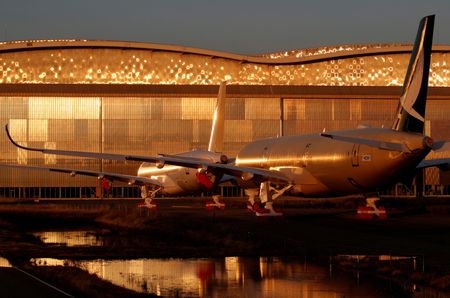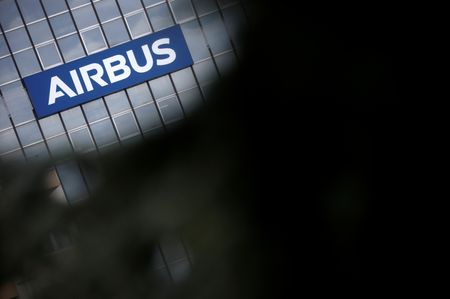

By Tim Hepher
PARIS (Reuters) -Airbus on Thursday slowed the production ramp-up of key narrowbody models after supply disruption, but surprised investors and some suppliers by raising output ambitions for the widebody A350 as long-haul routes join a global travel recovery.
In a bid to stabilise the supply base for the industry’s highest-volume jetliner model, Airbus reinstated a goal of 720 total annual deliveries, after abandoning it last year.
Chief Executive Guillaume Faury said Airbus had “lost a year” in its recovery but had a better understanding of supply problems weighing on plane deliveries since the pandemic.
Global supply chains have “stopped degrading” but Airbus has built ongoing disruption into its plans for 2023, he added.
Shares in the France-based group rose 4.9% after it posted a stronger-than-expected 5.63 billion euro ($6.02 billion) core profit for last year, up 16%, partly due to positive pension and legal effects, and predicted 6 billion in 2023.
The new targets for single-aisle jets confirm a shallower trajectory disclosed by industry sources last month, with the goal of 65 A320neo-family jets a month slipping to end-2024 and the rate of 75 slipping to 2026 from “middle of the decade”.
However, Airbus still has the lion’s share of the ramp-up ahead of it, with industry sources pointing to a current rate of 45 a month and a plan to exit the year at a fraction below 60 a month – a one-third hike rarely seen in aerospace.
Faury moved to reassure investors and customers – some of whom have been pressing for compensation for delays – that the new plan was credible. “We really believe that is feasible in the current environment,” he told analysts.
A Morgan Stanley survey of suppliers said the new output plans of Airbus and rival Boeing were no “slam dunk”.
Airbus’s 2022 revenues rose 13% to 58.76 billion euros, buoyed by higher deliveries compared to the previous year and a strong dollar.
Airbus delivered 661 jets last year after targeting 720 and then trimming the goal to 700 before ultimately abandoning it.
PRODUCTION OVERLAP
In January, Reuters reported that Airbus was tempering the pace of production increases and cited a senior industry source saying the delivery goal may not significantly exceed 720 jets.
In an internal call last week, Faury deplored weaker than expected January deliveries and warned executives Airbus must not deliver fewer jets this year than it had targeted in 2022.
Airbus, though, confirmed plans floated this week to raise A330neo output to four a month in 2024 from about three now.
It also announced plans to hike A350 output to nine a month “at the end of 2025” from around six now after selling jets to Air India The move surprised some suppliers who have been working to medium-term plans for A350 output to remain steady at six a month throughout 2024 and 2025, circulated just weeks ago.
Airbus has nonetheless been steadily talking up widebody demand as it battles resurgent sales of Boeing’s 787 Dreamliner. The Wall Street Journal reported higher output on Tuesday.
Air India said on Tuesday it would start taking most of its 470 new Airbus and Boeing jets from mid-2025. For a new client, large cabins – one of the hotspots still causing some supply difficulties, according to sources – need an 18-month lead time.
In other business, outgoing Chief Financial Officer Dominik Asam called 2022 an “annus horribilis” for the Defence & Space division after the loss of two satellites on a Vega C rocket and another hefty charge for its loss-plagued A400M troop plane.
Airbus said on Wednesday Asam would be replaced by German executive Thomas Toepfer, finance chief of Bayer spin-off Covestro, in September after what Jefferies analyst Chloe Lemarie called a “rather lengthy” six-month interim period.
Airbus is meanwhile seeking to become the No. 1 investor in French firm Atos’ soon-to-be spun-off cybersecurity arm Evidian, in a move Faury said showed its growing reliance on big data.
(Reporting by Tim Hepher;Editing by Sudip Kar-Gupta and Mark Potter)

